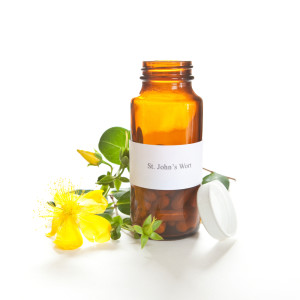Written by Marcia J. Egles, MD. Using a mouse model of a chemically -induced migraine event, researchers demonstrated that a single dose of St. John’s Wort blocked the migraine pain.
 Migraine is a headache disorder that affects nearly 15% of the population, with an estimated treatment cost of 17 billion dollars annually in the United States 2,3. Using an animal model of an induced migraine-like event, researchers evaluated St. John’s Wort 1 as a possible therapeutic agent to relieve migraine.
Migraine is a headache disorder that affects nearly 15% of the population, with an estimated treatment cost of 17 billion dollars annually in the United States 2,3. Using an animal model of an induced migraine-like event, researchers evaluated St. John’s Wort 1 as a possible therapeutic agent to relieve migraine.
St. John’s Wort (SJW), also called Hypericum perforatum, has been used for centuries as a medicinal plant. Some studies have shown effectiveness for its use in the treatment of minor to moderate depressive illness 4, however, its usefulness has been limited by its potential for dangerous “herb-drug interactions” 5. Although it is not recommended for patients who are pregnant or breastfeeding, when used alone without other medications, SJW has a history of relatively few side effects 4. The researchers of this study investigated the potential of a single, very low dose of SJW to diminish migraine-associated parameters in a mouse migraine model.
So, give a mouse a migraine? 6 Treat the mouse with SJW, then evaluate the mouse? This experiment, with control mice, is basically along those lines although an animal model for migraine is still very theoretical 1. Briefly, glyceryl trinitrate plus sodium nitroprusside were used in mice to produce an inflammation of the meninges (the lining around the brain) to mimic a migraine attack in groups of ten mice.
After 150 minutes, the treatment mice were orally administered one dose of a dried extract of SJW (5 milligrams SJW per kilogram of mouse mass) in solution. Mouse behaviors, particularly behavioral responses to cold and warm stimuli, and various biochemical parameters detailing inflammatory pathways were assessed at 2, 4 and 6 hours.
Overall, the researcher found that the single low-dose of SJW counteracted the chemically-induced, model migraine in the mice. Pain hypersensitivity and protein kinase C mediated pathways were blocked.
The one-time dosage of SJW used in the mice was relatively much less than comparable dosages used daily to treat chronic depression in humans. The low dosage might avoid much of the SJW’s issues with drug interactions. The researchers suggest that SJW is worthy of further evaluation as an agent to abort migraine pain and misery.
Source: N. Galeotti, C. Ghelardini. St. John’s wort reversal of meningeal nociception: A natural therapeutic perspective for migraine pain. EurJPain 17(2013) 369-381; doi:10.1002/j. 1532-2149.2012.00196x
© European Federation of International Association for the Study of Pain Chapters
Posted February 13, 2017
References:
- Galeotti N, Ghelardini C. St. John’s wort reversal of meningeal nociception: A natural therapeutic perspective for migraine pain. Phytomedicine. 2013;20(10):930-938.
- Vos T, Flaxman AD, Naghavi M, et al. Years lived with disability (YLDs) for 1160 sequelae of 289 diseases and injuries 1990–2010: a systematic analysis for the Global Burden of Disease Study 2010. The Lancet. 2013;380(9859):2163-2196.
- Mennini FS, Gitto L, Martelletti P. Improving care through health economics analyses: cost of illness and headache. The journal of headache and pain. 2008;9(4):199-206.
- Kasper S, Caraci F, Forti B, Drago F, Aguglia E. Efficacy and tolerability of Hypericum extract for the treatment of mild to moderate depression. European Neuropsychopharmacology. 2010;20(11):747-765.
- Di YM, Li CG, Xue CC, Zhou S-F. Clinical Drugs that Interact with St. John’s Wort and mplication in Drug Development. Current pharmaceutical design. 2008;14(17):1723-1742.
- Numeroff LJ, Bond F. If you give a mouse a cookie. Scholastic Incorporated; 1985.
